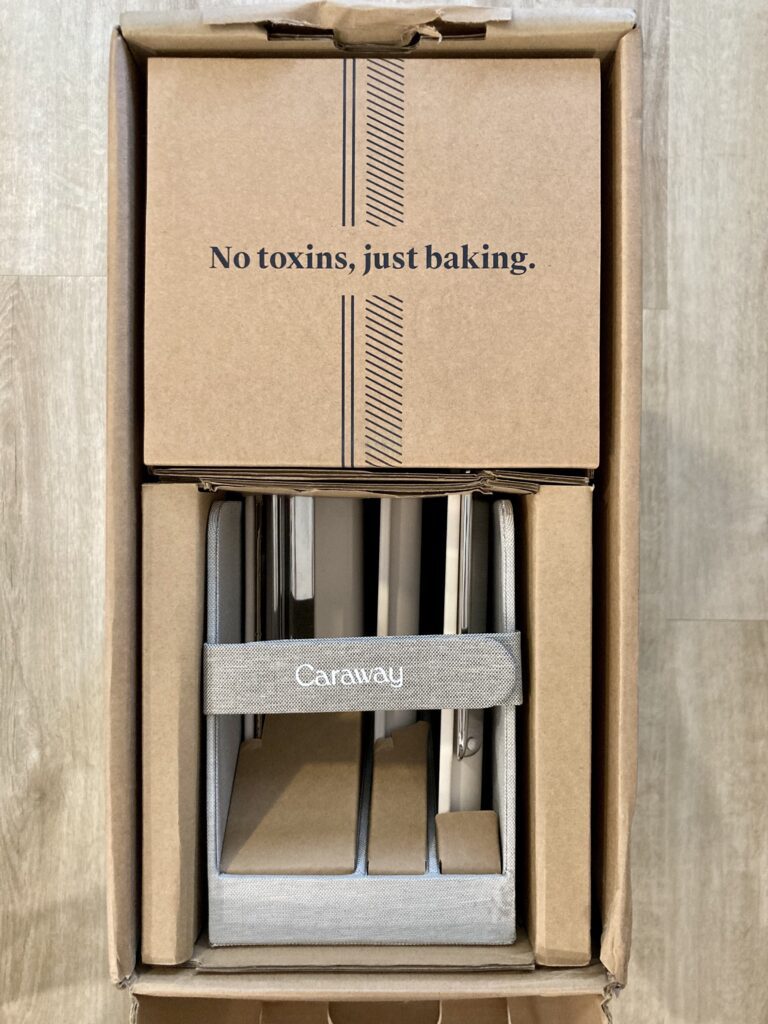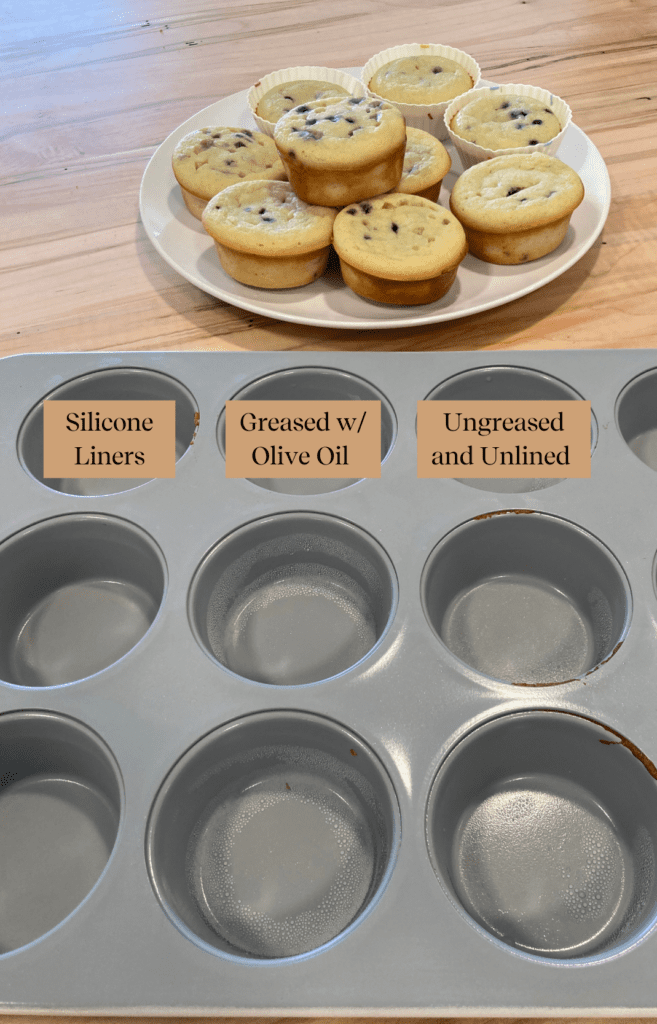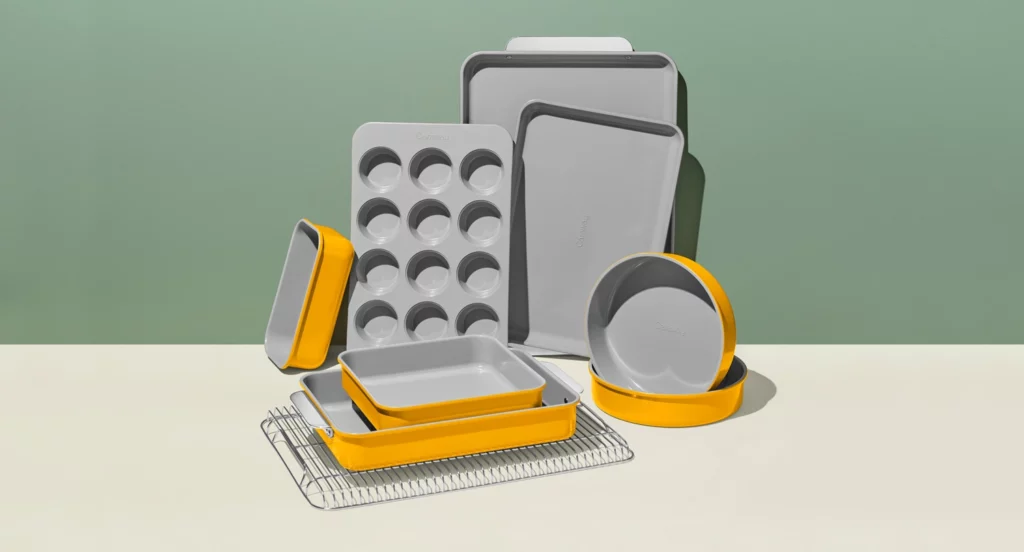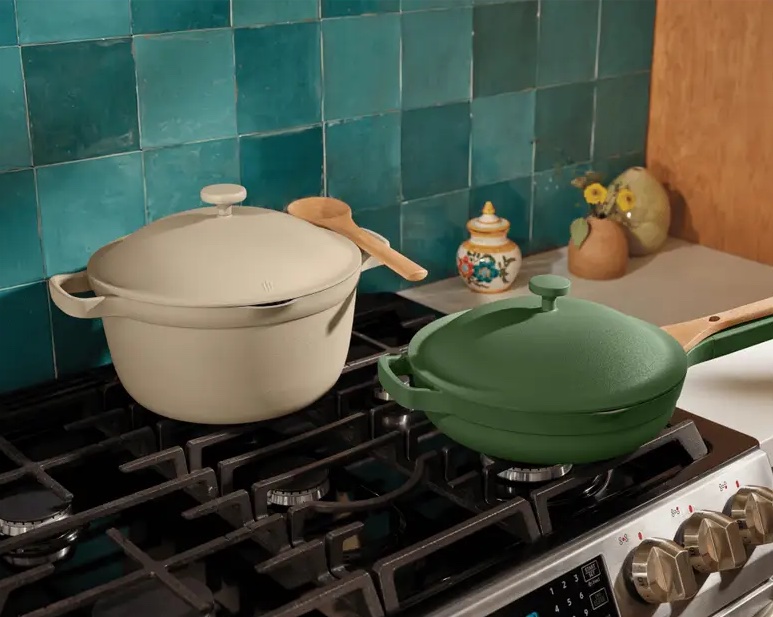Caraway is a modern cookware and bakeware brand that offers non-stick pots and pans that are free from toxic PFAS chemicals.
I wanted to see for myself if Caraway’s products lived up to the hype, and I was also in desperate need of some new baking sheets and pans!
So, I bought a bakeware set from Caraway and am sharing my thoughts with you here after using it for several months. I’ll also give you my opinion on whether or not Caraway is actually non-toxic and whether or not it’s worth the money.
Table of Contents
- What’s So Special About Caraway?
- My Honest Thoughts After Using Caraway Bakeware
- What I Like
- What I Don’t Like So Much
- How to Clean Caraway Pans & Baking Sheets
- Is Caraway Cookware Really Non-Toxic?
- So, Is the Caraway Bakeware Set Worth It?
- Where to Buy Caraway Cookware & Bakeware
- More Non-Toxic Bakeware Options
- How Does Caraway Compare to Other Ceramic-Coated Cookware Brands?
- More FAQs about Caraway:
This article is not sponsored and I purchased the bakeware. This article does contain affiliate links, which means we may earn a commission if you decide to make a purchase.

What’s So Special About Caraway?
Brands like Caraway (and GreenPan and Our Place) have gained a lot of popularity over the past decade or so. I believe this is mostly because as the dangers of toxic PFAS chemicals (which are used in conventional Teflon non-stick products) have become more widely known by the public, people want a safer alternative that’s just as easy to use. And I totally get that!
Caraway’s cookware and bakeware is ceramic-coated: it’s made with an aluminum core and then wrapped in a “ceramic” outer layer that’s actually made from a material called “sol-gel.”
There are different kinds of ceramic cookware. 100% ceramic cookware is actually quite different from ceramic-coated cookware. Furthermore, not all ceramic-coated cookware is created equally… Even though Caraway’s ceramic-coated cookware and bakeware is actually completely PFAS-free, many other brands actually still contain PFAS. You can read more about ceramic cookware here.


Caraway’s offerings include:
- Cookware (Fry Pan & Mini Frying Pan, Sauté Pan, Dutch Oven, Sauce Pan & Mini Sauce Pan)
- Bakeware (2 sizes of Baking Sheets, Rectangular Pan, Circle Pan, Square Pan, Loaf Pan, Muffin Pan, Cooling Rack)
- Food Storage containers of various sizes
- Linens (oven mitts, tea towels, aprons)
- Tea Kettle
- Organization containers
One thing that sets Caraway apart is that you can choose from a variety of different colors, so you can get a cookware set that feels more “you” or coordinates with your kitchen’s aesthetic. (I was feeling very indecisive so I ended up just going with the classic cream color. I figured I won’t get sick of it after several years!)
You can either buy each piece separately, or you can buy them as a bundle and save. The 8-piece cookware set is priced at $545, the 11-piece bakeware set is also priced at $545, or you can get the half bakeware set (5 pieces) for $295. Both the full and half sets automatically come with an organizer which can either be used in a cabinet or on the countertop.
I ended up getting the half bakeware set plus two circle pans (for double layer birthday cakes, of course!). It also came with several cork squares to protect the table and countertop.


My Honest Thoughts After Using Caraway Bakeware
What I Like
I like how lightweight the bakeware is. I can easily get it in and out of the oven one-handed if I want to, which is not something I can do with my heavy cast iron.
It’s also very easy to clean (more on that in a minute).
The non-stick aspect is the real deal. It’s definitely just as non-stick as any of the toxic Teflon bakeware out there. When using oil, a little bit goes a long way. You don’t have to worry about seasoning it like you do with cast iron or 100% ceramic. So far, I haven’t had any trouble with anything getting stuck to the pans or sheets.
To show you the non-stick properties, I made a batch of muffins…On the left column, I used silicone muffin pan liners. In the middle column, I pre-greased the pan with olive oil. And in the third column, I didn’t use any liners or grease at all. (The far right column I didn’t use at all; this mix only made 9 muffins.)
(Side note: I don’t necessarily recommend baking with silicone if you don’t have to because there’s some indication it may not be safe at high temps. I did it for this because I thought it would provide a sort of contrast for the other two columns, but it ended up being pointless.)
The video below shows me pulling the muffins from the pan for the first time. (I just let them cool for about 5 minutes first.) As you can see, the muffins come right out and there is no difference at all between the column I pre-greased with the olive oil and the column I left bare. There is almost no crusty muffin residue stuck to the pan, except a little bit around the top rim.

Side note: I used a dairy-free, gluten-free, sugar-free muffin mix for this, which is why the muffins aren’t very fluffy! Nothing to do with the muffin pan. 😉
What I Don’t Like So Much
I do feel like I have to be very careful with this bakeware. I’m aware that it’s not nearly as durable as my cast iron or stainless steel, so I treat it more gently. You have to use soft utensils—no metal knives, forks, or spatulas that could potentially scrape the coating.
I will definitely update this article after a couple of years to let you know how the bakeware is holding up over a longer period of time.
It’s also worth noting that Caraway isn’t meant to be used with high heat. They say their stovetop cookware should only be used on low and medium heat and the bakeware has a max heat of 550°. I’m not usually baking at that high of temperatures, but if you use the broiler a lot, it may not be the best option for you. (Most broilers are around 500-550°.)
How to Clean Caraway Pans & Baking Sheets
Caraway bakeware and cookware is not dishwasher safe which may be annoying for some people. I’m personally not bothered by this because I’m used to hand-washing my pots and pans.
I will say, however, that Caraway’s products are super easy to clean. The video below shows me cleaning last night’s dinner from my Large Baking Sheet. This was basically cooked-on juice from chicken breast, olive oil from roasted veggies, and salt & pepper.
I did not pre-soak the pan at all. All I did was put a few squirts of my Branch Basics foaming soap on the tray, ran the water over it, and gave it a light scrub. As you can see, it took 1 minute and 26 seconds from start to finish (and I was doing it with one hand while I held the camera with the other!).
In real life, I usually do a quick pre-soak, but I’m talking very quick—like a minute. And then whatever’s on the baking sheet comes right off. Super easy.
Is Caraway Cookware Really Non-Toxic?
There is some question about whether or not Caraway’s cookware (and ceramic-coated cookware from all brands) is truly safe.
Well, there’s not exactly a straightforward answer to that question. Here are the three main things to consider with regard to the safety of Caraway and other ceramic-coated brands:
1.Not all ceramic-coated cookware is actually 100% PFAS-free.
A lot of ceramic-coated cookware brands just take out one or two types of PFAS chemicals, but they haven’t remove all of them. If you go to Amazon and search for “ceramic cookware,” you’ll notice that a lot of the brands boast “PFOA-free” or “PFOS-free”… But those are just TWO out over 9,000 different chemicals in the PFAS family!
Caraway is one of the few brands that is actually 100% PFAS-free. When we reached out to them to verify this, they sent us third-party tests results showing no detection of various kinds of PFAS, including PTFE (which is one the most common ones found in ceramic-coated cookware brands today).
This is one of the reasons why IF you decide you’re going to use ceramic-coated cookware, I think Caraway is one of the best brands.
2. Lack of research about nanoparticles and the sol-gel ceramic coating.
In my opinion, this is one of the main reasons to consider not buying ceramic-coated cookware or bakeware (even if it’s PFAS-free).
At this time, we don’t have any evidence that the sol-gel coating used for this type of cookware is toxic, but we also don’t have much evidence that it’s safe either.
Some brands use nanoparticles in their sol-gel material, which can either be made with either titanium dioxide and/or silicon dioxide… There is some indication that titanium dioxide is harmful (depending on how it’s ingested); however, Caraway doesn’t actually use titanium dioxide. They use silicon dioxide instead.
Silicon dioxide is currently a considered a food-safe additive by the FDA, and it hasn’t garnered the same concern that titanium dioxide has. However, there is some indication that nanoparticles of all kinds may lead to GI problems as well as DNA and cell damage in the long run.
At this time, I whole-heartedly believe that PFAS-free ceramic-coated brands like Caraway are much safer than any of the other Teflon-type cookware and bakeware brands on the market. But that being said, if you’d prefer to take the precautionary approach, you may want to wait until there is more research into not only nanoparticles but also this sol-gel material as a whole.
3. Trace amounts of heavy metals(?)
This is a tough one. When we reached out to Caraway to ask about heavy metals, they sent us the results of two tests showing that they passed the California Prop 65 tests for lead and cadmium leaching. (Both metals were not detected in the tests.)
This is significant because although the Prop 65 lead exposure limit is not zero (it’s 15 µg/day), it’s very low. (This is partly why you see Prop 65 warning labels on so many products; it’s very difficult to get lead levels that low in things like electronics and certain agricultural products.)
But, it’s worth noting that Tamara over at Lead Safe Mama did find low levels of lead and other heavy metals on her Caraway pan when she did an at-home test. (I personally haven not taken an in-depth look at her methods.)
The thing is that exposure to trace amounts of metals is a potential risk with almost every kind of cookware. Xtrema, for example (which is 100% ceramic and one of the safest types of cookware you can buy), uses the same exact tests Caraway does for lead and cadmium.
Even cast iron (which again is one of the safest kinds of cookware and the kind I personally use the most), can be potentially problematic for people who have a history of heavy metal poisoning because it can leach small amounts of iron into your food.
Glass is a good option because even though it can also contain trace amounts of metals, it doesn’t have the same risk of leaching. But some people don’t like how breakable glass is. Also, good luck finding a glass muffin pan.
Of course, I believe it’s very important for us to do whatever we can to avoid lead and heavy metal exposure (especially for kids), as it can be very damaging. But at the same time, heavy metals are naturally-occurring substances and it’s impossible to avoid them 100%. It can be tough because we all have to focus on what we can actually control and make the best choice for ourselves and our families based on all of the information we have (even if it may not be perfect).

So, Is the Caraway Bakeware Set Worth It?
I wish I could give you a passionate yes or no answer to this question, but unfortunately, I can’t. Whether or not Caraway is worth it to you is going to come down to your own personal priorities, preferences and needs.
Personally, I like to mix it up. On the stovetop, I use cast iron the most. I use a glass pan for baking brownies. But Caraway is great for things like muffins and bread loafs. I also don’t mind the idea of using a Caraway baking sheet for things like roasting veggies because it’s lighter weight, easier to pull in and out of the oven, and I don’t have to use a bunch of oil if I don’t want to.
Price-wise, Caraway is pretty middle of the road. It’s more expensive compared to options like stainless steel or glass, it’s in the same range as cast iron, and it’s a little cheaper than Xtrema (the 100% ceramic brand).
BUT one big difference is that Caraway and other ceramic-coated cookware brands apparently just don’t last that long. The non-stick coating tends to wear down over time, which means it not only loses its non-stick functioning, but it also may become less safe as more chemicals become exposed and prone to leaching.
It’s also just more wasteful in the long-run, both in terms of money and how much cookware ends up in our landfills.
SO with all that being said, here are the general pros and cons wrapped up into a table along with what types of people I think would be more or less interested in giving Caraway a try…
Caraway might be a good fit for:
- Those who are transitioning from conventional Teflon non-stick pans for the first time.
- People who definitely want that super slippery non-stick feel.
- Elderly folks, people with certain disabilities, or people who definitely need lightweight cookware and bakeware.
Who Caraway would probably NOT be a good fit for:
- People who’d rather take the precautionary approach and wait until there’s more evidence on the safety of nanoparticles and the sol-gel coating material.
- People who live a low-waste and/or minimalistic lifestyle. (Cast iron and 100% ceramic bakeware will last generations, whereas you’ll probably have to replace your ceramic-coated cookware after several years.)
- People on a tight budget. (Some options, such as glass or stainless steel, tend to be more affordable.)
PROS
- Lightweight
- Easy to use (no learning curve if transitioning from traditional Teflon non-stick pans)
- Great non-stick performance
- 100% PFAS-free
- Looks pretty in the kitchen
CONS
- Not dishwasher safe
- Lack of research on safety of the sol-gel ceramic coating
- Wasteful. Doesn’t last nearly as long as alternatives like cast iron and 100% ceramic
- Kind of expensive
- Scratched or damaged pans may become more toxic

Where to Buy Caraway Cookware & Bakeware
The best place to get Caraway is directly from their website, as this will ensure you get the 1-year warranty as well as any deals they have going on.
But you can also pick up Caraway cookware from stores like Target, Crate&Barrel, and Nordstrom.
More Non-Toxic Bakeware Options
To learn more about the different types of non-toxic bakeware materials and more brands, check out our comprehensive guide to non-toxic bakeware. (And this guide covers stovetop cookware, although many of the materials are the same.)
Home
These Are The Safest Non-Toxic Bakeware Brands
Non-toxic bakeware can be a confusing topic. Learn which materials are safest for baking so that you can make the most informed decision for you and your family.
How Does Caraway Compare to Other Ceramic-Coated Cookware Brands?
GreenPan vs. Caraway

GreenPan is one of Caraway’s main competitors. It was actually one of the first brands to come onto the scene with PFAS-free non-stick cookware.
GreenPan and Caraway are very similar. They’re in the same price range and generally have the same features. While the exact formulation of their sol-gel coating differs slightly, they are both completely PFAS-free.
One big difference is that Caraway actually shared their third-party test results with us, but GreenPan wouldn’t, which is really frustrating. This is one reason I’d be more inclined to buy Caraway over GreenPan. (I will say, however, that the Ecology Center did their own testing on GreenPan and did not find any PFAS, lead, or cadmium. This does give me some peace of mind.)
GreenPan does have a lot more cookware options in terms of products, colors, and styles. But when it comes to ovenware (baking sheets, loaf pans, muffin pans, etc.), the two brands offer roughly the same products. GreenPan also has a sister company called GreenLife which is one of the most affordable ceramic options.
Our Place vs. Caraway

Our Place is also very similar to Caraway in that it is a non-stick cookware brand that is completely PFAS-free. The main difference is that the Our Place “Always Pan” and “Perfect Pot” are meant to be more versatile and minimalistic. You don’t need a whole cookware set; rather, you can do a lot of different things with just a few pieces.
Our Place doesn’t have as many options for the oven, though. They have an oven pan (which also doubles as a stovetop griddle), but they don’t carry a muffin pan, loaf pan, circle pans, or rectangular pans.
Our Place also has an enameled cast iron option, whereas Caraway does not.
Great Jones vs. Caraway
Great Jones is another direct to consumer cookware brand with a trendy vibe. Great Jones offers a lot more options in terms of materials—they have cast iron, enameled cast iron, stainless steel, ceramic-coated stone, and ceramic-coated steel.
Great Jones and Caraway are pretty similar in terms of price range and types of products offered (fry pans, dutch ovens, baking sheets, etc).
However, the biggest difference here is that not all of Great Jones’ products are completely PFAS-free. While their cast iron and stainless steel options are likely safe, their ceramic-coated products may contain PTFE and/or PFOS.
HexClad vs. Caraway
HexClad is unique because it’s a hybrid cookware with a surface that’s both stainless steel and non-stick. Because of this, it’s said to be more durable that ceramic-coated cookware while still having the convenience of non-stick.
Caraway and HexClad are generally in the same price range.
HexClad needs to be pre-seasoned before you use it, whereas Caraway does not.
HexClad says its pans are dishwasher safe, whereas Caraway’s are not.
But most importantly, HexClad’s cookware it NOT totally non-toxic. They do contain some PTFE, which is a kind of PFAS chemical.
More FAQs about Caraway:
Where is Caraway Cookware Made?
Caraway cookware is made in China. While this may not be ideal for some consumers, we have yet to find any ceramic cookware brands that are made in the USA.
Who owns Caraway cookware?
Caraway was founded by Jordan Nathan, who is still the CEO. The company has raised multiple rounds of funding but it’s still privately owned and is not owned by any larger corporation.
Are Caraway Pans Oven Safe?
Yes, you can use all of Caraway’s cookware in the oven, up to 550°. That includes the bakeware as well as the stovetop Caraway products like the Fry Pan, Sauce Pan, and Dutch Oven.






This article is very helpful and well written. Thank you!